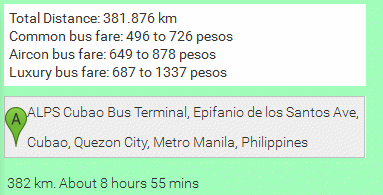Fees - Taxes - Rates
It's more fun in the Feelippines
Hidden costs
Many people spell Philippines as Fee-lippines because of all these taxes and fees one has to pay when traveling. Your well calculated travel budget can get off the track because of all the hidden taxes and fees you will have to pay.
Two samples to illustrate this problem. These are the short boat trip from Caticlan to Boracay and the airline fares.
The fare for the short boat-ride from Caticlan to Boracay is 25 Pesos only. But you have to pay 200 Pesos! With your boat ticket you also have to pay the terminal fee of PHP 100 and the "Environmental and Admission Fee" of PHP 75. Please read more below.
Airlines in the Philippines sell tickets at incredible low fares. But when you pay your ticket, you see a very long list of so called add-ons. For promo-tickets these add-ons are a multiple of the ticket price. And then the government wants also money from you.
Please read also our new
Tax & Fee Refund page.
Terminal Fee
A terminal fee has always to be paid when using a port or an airport for departure. On arrival you never have to pay any terminal fee. When you transfer at an airport you will only have to pay the terminal fee when:
- you are arriving from abroad
- your connecting flight is not on the same day
- you depart from another port or airport
Important: When in transit then you must show the terminal fee ticket from your last airport otherwise you pay a new fee. Please read also our "Manila Transfer page".
|
Terminal fee is included in ticket price: Manila: all flights (international and domestic). Cebu: Clark: none included. All other airports: |
Some sample terminal fees:
- PHP 550 - 750 for all international flights
- PHP 200 - 220 for domestic flights from big airports
- PHP 20 - 50 for small domestic airports
- PHP 2.50 - 100 for seaports
In some seaports you may also have to pay a small community tax of 1 to 8 pesos. This tax should help local people to maintain the port's infrastructure.
In some tourist spots you also will have to pay a visitors fee, an environmental fee, a cleaning fee or any fantasy fee.
These fees are listed and explained in the island sections.
For cars on Ro-Ro ferries (Roll-on Roll-off) you have to pay an extra RoRo-Terminal fee. This fee includes the car and the driver. See also our Sea Travel pages.
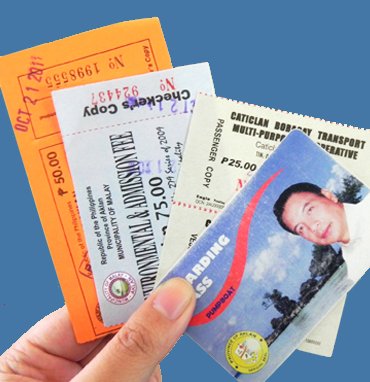
Travel Tax
The travel tax is imposed by the Philippine government on individuals who are leaving the country irrespective of the destination.
|
Travel tax is included in ticket price: Manila: all international flights All other airports: not included |
The following individuals are subject to pay the travel tax before or upon departure:
- Filipino Citizens
- Permanent Resident Visa Holders of:
- Immigrant Visa - Quota (13)
- Immigrant Visa - Non-Quota Permanent Resident (13A)
- Children of Immigrant Mothers (13B and C)
- Returning Filipino Resident (13D)
- Returning Resident (13E)
- Returning Former Filipino Citizen (13G)
- Temporary Resident Visa (13A)
- Foreigners covered by Alien Social Integration Act of 1995 (RA 7919)
- Recognition as Filipino Citizen (RC / RFC)
- Permanent Resident (RA 7837)
- Non-immigrant visa holders who have stayed in the Philippines more than a year.
Note: Non-immigrant visa holders who have stayed in the Philippines less than one year and tourists are not subject to pay the travel tax.
If you are subject to pay this tax (see below) be careful. If you do not pay the tax in advance, you may risk that the counter at the airport is closed. This happens sometimes on public holidays. And if the counter is closed, you get no receipt and without receipt the airline does not check you in. On the other hand, the travel tax is often included in the ticket price. If you are sure that your departure day is not a public holiday, then go first to the check-in counter of your airline. If the travel tax is included in the ticket price, you have no further problems. Otherwise you will have to go to the travel tax counter at the entrance and re queue for your check-in.
Note: We recommend to read the TIEZA website http://tieza.gov.ph
Travel Tax Rates
| Tax Class | 1st Class Passage | 2nd Class Passage |
| Full Rate | PHP 2,700 | PHP 1,620 |
| Standard Reduced Rate | PHP 1,350 | PHP 810 |
| Privileged Reduced Rate for Overseas Contract Workers' Dependents |
PHP 400 | PHP 300 |
Processing fee is PHP 200.00 per Certificate
TIEZA stands for Tourism Infrastructure and Enterprise Zone Authority (TIEZA). At this moment you only can pay the travel tax in the TIEZA offices and at TIEZA counters in the airports. You need your flight ticket and your passport with a valid visa. We recommend to pay the tax some days before you leave because sometimes the offices in the airports are closed.
Note: For offices please see the TIEZA website http://www.tieza.com.ph
NEW: Pay the Travel Tax on-line:
TIEZA on-line payment does not work at all!
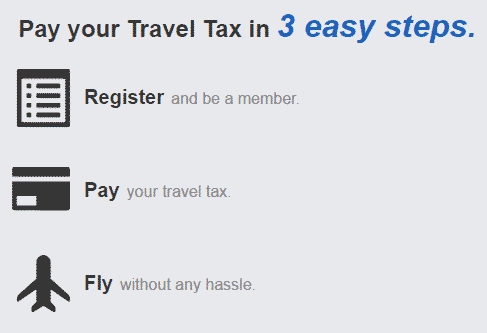
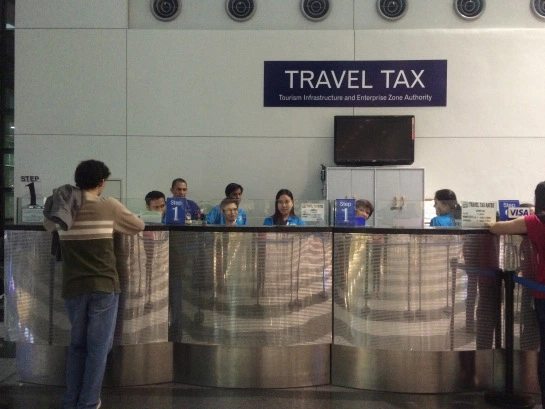


VAT and more
In the Philippines the BIR (Bureau of Internal Revenue) collects a tax on goods and services. The standard percentage is 10% of the 'gross selling price'. More information can be found on the website of the BIR.
Most of the displayed prices do contain the VAT, but some restaurants and resorts announce "net prices" and add 12% VAT to the bill.
On restaurant bills you very often find another add-on amount called "service charge". If you find this charge on your bill, we explicitly recommend not to give a tip to the server. Otherwise you pay it twice!

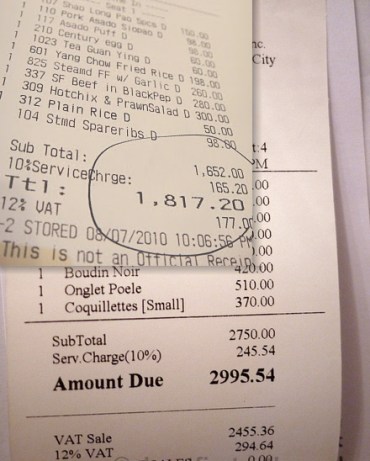
Airline fares
Prices for flight tickets change from minute to minute. They are calculated on the base of available seats for a particular flight. Flights in the morning and evening are more expensive then mid-day and early and late flights. Weekends are more expensive then flights in the middle of the week. Calculating airfares is a big bunch of mathematics for the airlines.
Usually the earlier you book the lower is the rate. Christmas, Easter and the vacation season in March/April are always expensive. For some flights the expected number of passenger is not reached, so the prices go again down a day or so before the flight is scheduled. It is an always amazing game to compare the fare paid with your seat-neighbor.
Do not believe in the advertisements of the airlines. The fares of the one who claims the title of the cheapest airline can suddenly be much more expensive than the fares of the so called largest company in the country.
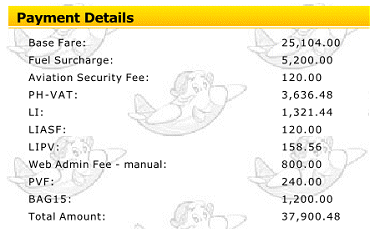
For above tickets we had to add 50% of the announced fare in taxes and fees and surcharges. We would prefer WYSIWYP fares: What you see is what you pay.
Note: Be careful when traveling on tight budget. Do always a mock-booking up to the moment where you have to pay. This is the only way to know the final amount.
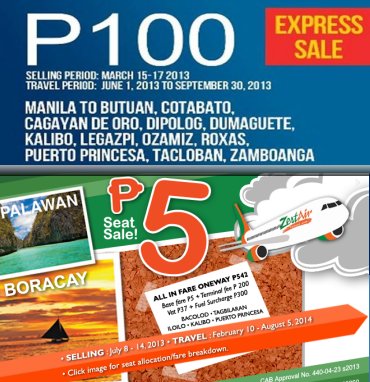
Ferry & Ship fares
Unlike the bus rates you can find the ferry fares on the Internet. At least the Philippines key players in the ferry business do publish their fares and timetables. On some sites you may book your ticket on-line. Please see our Sea Travel page.
For the other companies and some secondary destinations you can calculate the ferry rates the same way you do with the buses:
a) Estimate the number of kilometers of your journey. (Google-Earth is a good tool.)
b) The fare per kilometer is around 8 pesos per kilometer even on fast air con ferries. But on routes served by only one company the fare can go up to 10 to 12 pesos per kilometer on a rusty old steamer.
c) Add 2.50 to 50.00 pesos for the terminal fee in the port. (Please see above)
The big shipping companies have their own websites where you can reserve and book your journey. Please see our Sea Travel page.
The provincial ferry companies do even not sell tickets in advance (e.g. Super Shuttle Ferry). Except of Christmas and Easter vacation you can be sure to find a seat or a bed on such ferries just before departure. Simply go to the port and ask. But be advised that schedules are rarely published and when the engine of the ferry is down, there is simply no ferry.
If you travel with your own car, you should start to plan, inquire and reserve at least two - better four weeks, before traveling. And even doing so, surprises will be guaranteed.
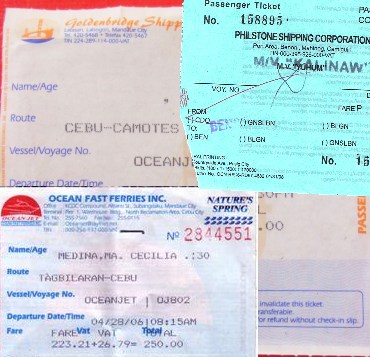
Bus fares
There are basically two kinds of bus fares.
On long distances bus companies offer fixed rates. For example Victory Liner sells tickets from Manila to Baguio at PHP 715 in a deluxe bus with toilet.
The usual system is to get on a bus anywhere and get also off somewhere. What you pay depends on the number of kilometers between anywhere and somewhere. It also depends on the bus class.
The ticket below shows a ride from kilometer 224 to kilometer 178. This makes a total of 46 km. The fare is PHP 51.
This is composed of PHP 5 for flag-down and 46 km at PHP 1.00 per kilometer.
We have created a Bus Fare Calculator on our bus page. It calculates the minimum and maximum fares for any distance in the Philippines.
Unfortunately the bus companies do not publish their fares on the web. Sometimes you can find a printed timetable with fares at the large bus-stops.
There is now a website, where you can check schedules and fares and book tickets on-line: phbus.com
Read more about traveling by bus in our Bus travel page.

Jeepney & Tricycle
Jeepneys and multicabs ply the mid-range routes up to 100 km. Tricycles and motorelas drive you from 1 to 20 kilometers and pedicabs drive you from a few hundred meters up to some kilometers.
Their tariffs and fares are the most difficult to estimate. There are laws and regulations, but if you do not know them, you will have to pay the fare the driver is asking for.
The Land Transportation Franchising and Regulatory Board (LTFRB) publishes the current fares and tariffs for buses, jeepneys and taxis. Please see here LTFRB and click on Fare Rates.
Usually jeepney fares are 8 pesos for the first 4 kilometers and then 1.40 peso per kilometer and pax. Tricycles are more expensive. They charge 9 pesos per kilometer and passenger. Be careful when you take a tricycle alone. The driver will charge the "exclusive fare". This means you pay the per pax fare multiplied by the maximum number of 9 (nine!) pax. So one kilometer can cost you 81 pesos.

Some local administrations publish official tariffs. In Camiguin, the fares are not only posted on all ferries, but also displayed in the port of Benoni.
Note: Please negotiate your fare in advance. There is nearly no possibility to complain afterwards. Don't be hard in bargaining, the driver often feeds a whole family.

